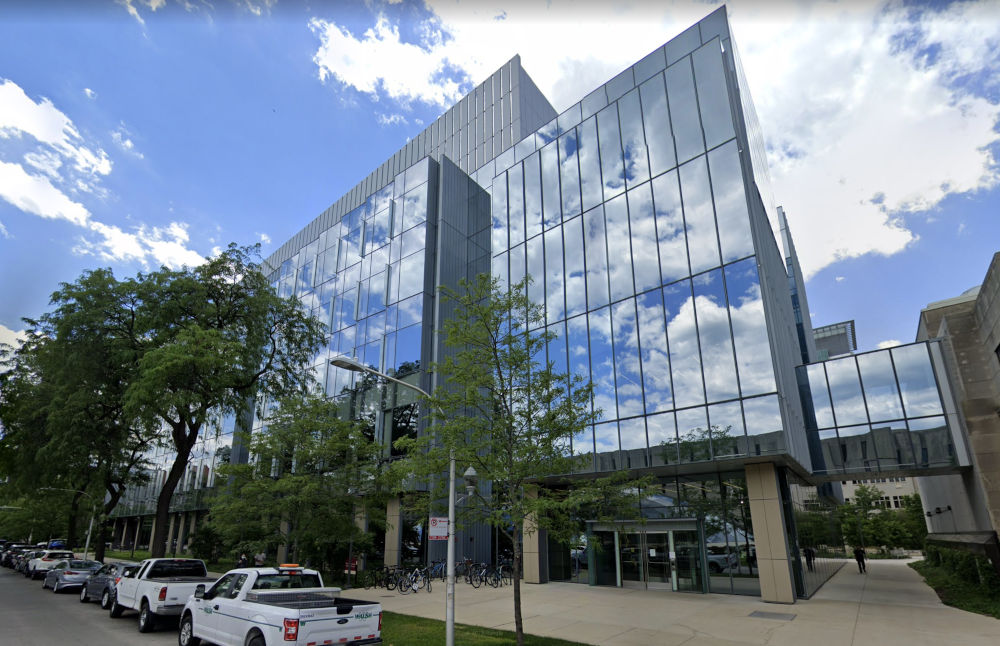William Eckhardt Research Center
🚨
Chicago Building ID: 254382

Attribution:
© Google 2024
Image Source
. Cropped from original.
Building Info
- Square Footage
- 284,391 sqftHigher than 73% of all buildings2.0x median139,707 sqft1.9x median Laboratory150,729 sqft
- Built
- 2015
- Primary Property Type
- Laboratory
- Community Area
- Hyde Park
-
Chicago Energy Rating
- 2.0 / 4
- Owner
 View All Tagged UChicago Buildings
View All Tagged UChicago Buildings
Note: Owner manually tagged. Logo used under fair use.
Emissions & Energy Information for 2022
- Greenhouse Gas Intensity
- 40.9 kg CO2e / sqft#9 Highest in Chicago* 🚨#2 Highest of Laboratories 🚨6x median6.4 kg CO2e / sqft1.7x median Laboratory23.5 kg CO2e / sqft
- Total Greenhouse Gas Emissions
- 11,638.6 metric tons CO2 eq.#2 Highest of Laboratories 🚨Higher than 98% of all buildings13x median885.8 metric tons CO2 eq.2.7x median Laboratory4,237.4 metric tons CO2 eq.
- Source Energy Usage Intensity
- 794.6 kBtu / sqft#10 Highest in Chicago* 🚨#3 Highest of Laboratories 🚨6x median132.2 kBtu / sqft1.7x median Laboratory461.2 kBtu / sqft
- Site Energy Usage Intensity
- 508.4 kBtu / sqft#6 Highest in Chicago* 🚨#2 Highest of Laboratories 🚨6x median78.4 kBtu / sqft1.7x median Laboratory299.9 kBtu / sqft
- Natural Gas Use
- 0 kBtu#2 Lowest of Laboratories 🏆Lower than 97% of all buildingsMedian Chicago Building5,818,399.6 kBtuMedian Laboratory91,419 kBtuThis Building Uses District Heating ❗
Although this building didn't burn any natural gas on site, it's connected to a district heating system, a centralized system for heating multiple buildings. District heating systems can be fully electric, but in Chicago most district heating systems are natural gas powered, meaning this building was most likely still heated with natural gas.
- Electricity Use
- 42,256,906.8 kBtuEst. Electric Bill: $1,771,000 for 2022**#3 Highest of Laboratories 🚨Higher than 96% of all buildings11x median3,796,376.7 kBtu2.6x median Laboratory16,507,348 kBtu
- District Steam Use
- 49,638,647.4 kBtu
Most buildings don't use district steam, so we don't currently have comparison data.
- District Chilled Water Use
- 52,691,107.5 kBtu
Most buildings don't use district chilling, so we don't currently have comparison data.
* Note on Rankings: Rankings and medians are among included buildings, which are those who reported under the Chicago Energy Benchmarking Ordinance for the year 2022, which only applies to buildings over 50,000 square feet.
** Note on Bill Estimates:
Estimates for gas and electric bills are based on average electric and gas retail
prices for Chicago in 2021 and are rounded. We expect large buildings
would negotiate lower rates with utilities, but these estimates serve as an upper bound of
cost and help understand the volume of energy a building is used by comparing it to your own
energy bills!
See our
Chicago Gas & Electric Costs Source
for the original statistics.
Data Source:
Chicago Energy Benchmarking Data
What Should We Do About This?
Practically every building has room to improve with energy efficiency upgrades like insulation, switching to ENERGY STAR rated appliances, and more, but for any buildings with large natural gas use, we recommend one thing: electrify!
In other words,
buildings should look to move all on-site uses of fossil fuels (including
space heating, water heating, and cooking) to electrically powered systems like
industrial grade heat pumps, heat pump water heaters, and induction stoves. With Illinois'
current electric supply, just using the same amount of energy from electricity, rather
than natural gas (aka methane) will dramatically reduce greenhouse gas emissions.
This is because Illinois' grid in 2020 was already 67% carbon-free
(see Illinois - Power | DecarbMyState ).
This has already been done across the country with a variety of buildings, large and
small, like the
Hotel Marcel
.
You can help make this a reality by talking to building owners and letting them know that a building's emissions are important to you, and that you want to see their building become fully electric and stop emitting greenhouse gases. Particularly for buildings you have a financial stake in (like your university, work, condo building, or apartment building) your voice in concert with your fellow building users can have a huge impact.
Additional Resources
See some additional resources on improving energy efficiency and understanding this data: